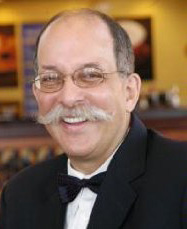
The Modern Butlers’ Journal volume 9, issue 7
International Institute of Modern Butlers
 Message from the Chairman
Message from the Chairman
Reviewing the prospects for our profession, they seem rather bright in an economy that does not otherwise offer much encouragement: the number of billionaires is set to double in the next seven years, and the number of HNW (High Net Worth) individuals (assets of $30 million and up, which has for many years been my own estimate of the wherewithal required for employers to take on butlers) will likewise increase 50%. While much of this growth is anticipated to take place in Asia and the Middle East, rather than the traditional European and United States markets, the increased demand for butlers and other household staff is still being seen in these countries, resulting in less time being spent looking for positions by those who have viable resumes. As disconcerting and uncertain as being between jobs may seem, rest assured that employers are actually desperate for reliable and competent staff, so my advice is to pass by those with high-turnovers and do not give in to those seeking, irrationally, to penny pinch on the remuneration package.
Please enjoy this newsletter—I learned something from the Canadian wines article; you may, too.
Letters to the Editor
“Good newsletter, thank you. Talking about employer ethics reminds me of John Gielgud’s line as the butler in Murder on the Orient-Express (1975), when he says something along the lines of ‘We should ask for the employers’ references rather than being asked for our own.’ Unfortunately, today, we have replaced privilege of birth with privilege of money, and the results are pretty horrible.” GL
“I have read your many articles and they have been of a great help to me. I would like to ask a few questions: In a five-star resort, would you set up one butler appointed to one room or for several rooms? What would be the difference between concierge service and butler service? What would be a medium-range salary for a butler in a resort?” AL
Editor: How many rooms a butler has to service depends on the quality of the butler offering to which the hotel or resort wants to aspire. Obviously, one butler per room/suite/villa would be expensive to maintain but would provide a level of service comparable to private service. In practice, either small boutique hotels/villas offer one butler per room/villa, or the top suites of hotels and resorts offer a butler dedicated to that suite, while guests in the other (or some of the other) suites share their butler.
Concierge Service is front of the house, offering assistance generally with guest requirements external to the hotel. The butler is in the suite, servicing the guests. This can include providing concierge service, especially when there is no concierge, or where the concierge handles the greater hotel, while the butlers service just some of the hotel guests. Generally, where there is a good concierge department, it is better for the butler to work with and through the concierge(s) for external requirements of guests.
Butler salaries in resorts really depend on the location of the resort. Butlers would typically make 15-40K (USD) in salaries, but tips are generally considered to double the take-home. Butler Managers make 25-50K, and if they are part of the tip sharing, then add to that figure according to the percentage of the tips that are apportioned to the Head Butler. I suggest the top end of the salary ranges would apply to the West, the lower-end to “developing countries.”
“Your answers have been a great help in this project.” AL
Butlers in the Media
The star-studded movie, The Butler, will be released on August 16 and is well worth viewing as our profession takes the lead role. It may not be the typical butler role, as White House Butlers have a narrowly focused job description compared with the Butler Administrator/Household or Estate Manager, and the focus is on the racial and political elements one would expect of household staff who are mostly African Americans serving nothing but a revolving series of political leaders. But the basic elements of butling and service are in place and well portrayed by Forest Whittaker, an actor who throws himself into the role based on extensive research to understand the mindset and behavior patterns of his roles. The movie is a serious look at a butler at work, modeled on real life rather than fiction—with the butler as the central character, the movie promises to add to the stature of our profession.
An interesting take from the New York Times on the future of the luxury hotel market.
The Institute’s Chairman was featured in a local upscale magazine recently (go to pages 52 onwards).
Consulting the Silver Expert
Mr. Jeffrey Herman has offered his services to our readers, for any questions you may have about the care of silver. Either call him at (800) 339 0417 or email jeff at hermansilver.com.
Here is the first enquiry, answered with great speed:
Q: How can I remove the build-up of old paste on brass door handles? Also, we have water glasses that are clouded, but I cannot remove the fog with simple acidic bases, such as white vinegar with hot water. Any suggests?
JH: “For the brass, I would use this method. If you’re afraid of splashing water on the woodwork, spread some Purell on the area and let it soften the polish, then tap the polish with the brush bristles, which will lift the polish. Use a cotton towel or cotton ball to remove the residue. Just remember to use some form of liquid to soften the polish FIRST, and lift it out with a natural bristle brush to avoid scratching.
“For cloudy glass, I highly recommend Cindy who has done some fantastic work for me. Take a look at her before-and-after images. Her pricing is also very reasonable! Glass sickness is something to be left to a professional.”
Serving a Cigar, Part 1 of 2
Whether serving a cigar in private service or in a hotel or resort, the rules are very much the same. The only real difference being that in a hotel, the guest usually orders the cigar off a menu, while in private service you may be expected to know what cigar(s) your principal smokes. It stands to reason that if you are in the hotel trade, you must be highly familiar with the cigars on your menu and know them well enough to make suggestions for beginners and perhaps make recommendations for matching certain cigars with certain liqueurs or cognacs.
In a hotel environment, your guest may want to inspect the cigar, but be careful to avoid their handling them in a way that may damage the cigar or which could be considered unhygienic by other guests. Never assume that you should go ahead with cutting and lighting the cigar. Cigar smokers are usually quite particular about how their cigar is cut and they have to know you and trust you before they will let you do it. Do not take offense if the smoker prefers to do the cutting and lighting himself. Many aficionados regard this prelude as one of the highlights of the experience or will want it done ‘just so’.
In this case, bring the cigar to the guest on a silver salver. I prefer to place it on a bright, clean, white napkin folded in a simple square, which is placed on the salver. For the short distance from the humidor to the guest, it may not be necessary to cover the cigar. However, if you were taking the cigar for service in a room or suite, you should cover it with a fold of the napkin. Follow the rules for handling a cigar as mentioned in the earlier chapter on care and storage. Remember that if you are serving the cigar away from the hotel’s cigar lounge, you may need to bring a cigar ashtray—make sure that it is perfectly clean and presentable.
Unless you know the smoker’s preferred method of cutting, you should also provide a selection of cutters and a good lighter. (A good lighter is fully charged and operational—it can be relied on not to go out halfway through the lighting process.) Present the cigar to the guest for inspection and let the smoker cut and light. He may let the cap fall onto the salver when he returns the cutter. If he does, you can flip the napkin when walking back to your service station, so that it is not visible to other guests. Back at your station, discard the cap and remember to change the napkin often.
 Let’s Talk about Wine, Part XVI
Let’s Talk about Wine, Part XVI
by Amer Vargas
This month we visit the land with a red Maple leaf in its flag: Canada. The country is unjustly not too well-known for its wines, as wine consumers are misdirected by the cold temperatures and harsh winter weather, with springs that can bring freeze-and-melt cycles and summers that are very humid. In spite of all this, Canadian vintners have learned and developed techniques to overcome their challenges.
Over two centuries ago, early settlers failed to cultivate vitis vinifera (European wine grapes) plants, so they turned to continental labrusca and riparia grapes instead. These withstood all Canadian weather conditions, but made such low-quality wine that it had to be fortified in order to make it drinkable and sellable. The last four decades, however, have seen major changes and improvements that have put Canada firmly onto the wine-world map: better trellising systems and control of vineyards have allowed European grapes to be cultivated and some vintners have even managed to cross continental and European vines—varietals like Vidal, Seyval Blanc and Baco Noir—for a hybrid sporting the best of each: better taste and the ability to withstand rough climates. These varietals represent a very small percentage of the current Canadian wine production, with most wine still being made from only European varietals.

In Canada, wine regions are mostly concentrated in the southern ends of Ontario and British Columbia. The vast majority of wineries and vineyards in British Columbia are located in the desert-like area of the Okanagan Valley, where Chardonnay, Pinot Blanc and Pinot Gris are used for whites, whilst Pinot Noir, Merlot and Cabernet Sauvignon are used to create quality red wines.
In Ontario, more than 2/3rds of vineyards are concentrated in the Niagara Peninsula, which accounts for more than 80% of the country’s wine production. In terms of production, Vidal, Chardonnay, Riesling and Sauvignon Blanc have a special presence when talking about white wines from this region; the red counterparts grown here are Cabernet Franc, Merlot, Cabernet Sauvignon and Baco Noir.

A unique feature about both British Columbia and Ontario is their ability to produce ice wine consistently each year. Ice wine is a dessert wine made from grapes that have been frozen while still on the vine. The water in the grape freezes, but the sugars and other solids do not, creating a concentrated grape must. This wine’s journey starts with a quick harvest on a very cold morning (to ensure the grape does not thaw when harvested) and an equally quick pressing. The rest of the process remains the same as with other wines. The result is a characteristic, refreshing sweetness balanced by high acidity.

And for those who enjoy that sweetness and high acidity, the end of the 20th century saw the birth of its sparkling version, discovered by chance by Canadian wine writer Konrad Ejbich in his home cellar, and first produced for commercial sale by Inniskillin Wines. Since 1998, they use the Charmat method, involving a double fermentation in bulk tanks—the result is just too delicious!
To good fortune, I raise my bubbly ice wine!
The Institute is dedicated to raising service standards by broadly disseminating the mindset and skills of that time-honored, quintessential service provider, the British Butler, adapted to the needs of modern employers and guests in staffed homes, luxury hotels, resort, spas, retirement communities, jets, yachts, & cruise ships around the world.


